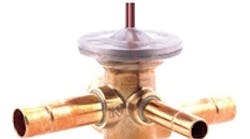Emerson Climate Technologies’ new C-Series TXV is designed and optimized for use with R-410A systems. Company spokespersons say the C-Series provides enhanced precision superheat control for improved compressor protection.
A. A valve with a low charge (or no charge) in the power element will tend to starve the evaporator. This is because the pressure on top of the diaphragm (opening force) is reduced.
To check for this, the following procedure is recommended:
- On a valve with an external superheat adjustment, turn the adjustment nut to the full counterclockwise position. Verify that the superheat is still too high before proceeding to the next step.
- Remove the bulb from the suction line and hold it in your hand for several minutes to warm it up. Observe the suction pressure. If the valve has charge, you should see an increase in suction pressure.
- If no change in suction pressure occurs, it’s reasonable to conclude the valve has lost its charge and must be replaced.
Note: Some valve types have removable power elements which can be replaced in lieu of replacing the entire valve. If the power element can be removed, the bulb charge can be checked by trying to depress the diaphragm with your thumb. You should NOT be able to depress this by hand. If you can, the valve has lost its charge.
— Information provided courtesy of Emerson Climate Technologies, St. Louis, MO. Visit www.emersonclimate.com for additional information.








